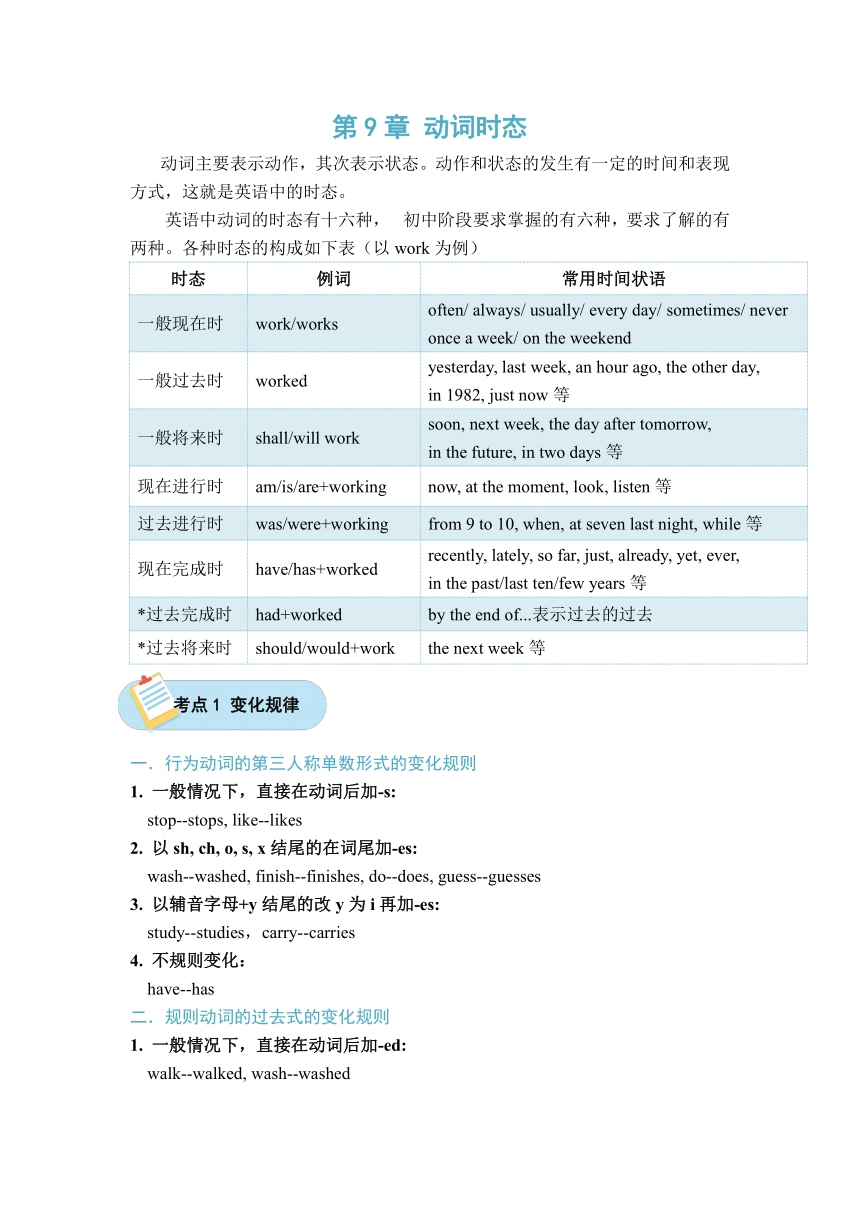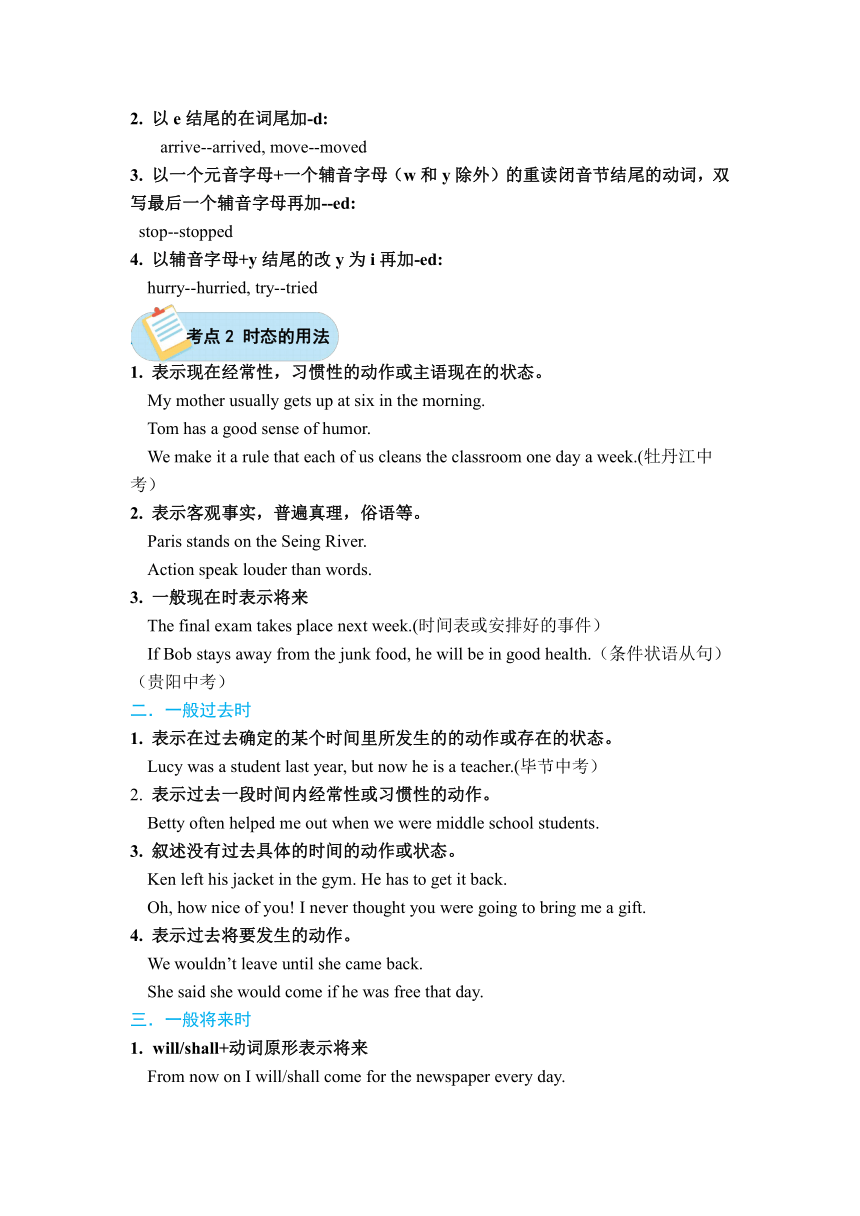2024年中考英语语法复习讲义 动词时态
文档属性
| 名称 | 2024年中考英语语法复习讲义 动词时态 |  | |
| 格式 | docx | ||
| 文件大小 | 39.0KB | ||
| 资源类型 | 教案 | ||
| 版本资源 | 人教新目标(Go for it)版 | ||
| 科目 | 英语 | ||
| 更新时间 | 2024-06-26 15:09:56 | ||
图片预览


文档简介
第9章 动词时态
动词主要表示动作,其次表示状态。动作和状态的发生有一定的时间和表现方式,这就是英语中的时态。
英语中动词的时态有十六种, 初中阶段要求掌握的有六种,要求了解的有两种。各种时态的构成如下表(以work为例)
时态 例词 常用时间状语
一般现在时 work/works often/ always/ usually/ every day/ sometimes/ never once a week/ on the weekend
一般过去时 worked yesterday, last week, an hour ago, the other day, in 1982, just now等
一般将来时 shall/will work soon, next week, the day after tomorrow, in the future, in two days等
现在进行时 am/is/are+working now, at the moment, look, listen等
过去进行时 was/were+working from 9 to 10, when, at seven last night, while等
现在完成时 have/has+worked recently, lately, so far, just, already, yet, ever, in the past/last ten/few years等
*过去完成时 had+worked by the end of...表示过去的过去
*过去将来时 should/would+work the next week等
行为动词的第三人称单数形式的变化规则
一般情况下,直接在动词后加-s:
stop--stops, like--likes
以sh, ch, o, s, x结尾的在词尾加-es:
wash--washed, finish--finishes, do--does, guess--guesses
以辅音字母+y结尾的改y为i再加-es:
study--studies,carry--carries
不规则变化:
have--has
规则动词的过去式的变化规则
一般情况下,直接在动词后加-ed:
walk--walked, wash--washed
以e结尾的在词尾加-d:
arrive--arrived, move--moved
以一个元音字母+一个辅音字母(w和y除外)的重读闭音节结尾的动词,双写最后一个辅音字母再加--ed:
stop--stopped
以辅音字母+y结尾的改y为i再加-ed:
hurry--hurried, try--tried
一般现在时
表示现在经常性,习惯性的动作或主语现在的状态。
My mother usually gets up at six in the morning.
Tom has a good sense of humor.
We make it a rule that each of us cleans the classroom one day a week.(牡丹江中考)
表示客观事实,普遍真理,俗语等。
Paris stands on the Seing River.
Action speak louder than words.
一般现在时表示将来
The final exam takes place next week.(时间表或安排好的事件)
If Bob stays away from the junk food, he will be in good health.(条件状语从句)(贵阳中考)
一般过去时
表示在过去确定的某个时间里所发生的的动作或存在的状态。
Lucy was a student last year, but now he is a teacher.(毕节中考)
表示过去一段时间内经常性或习惯性的动作。
Betty often helped me out when we were middle school students.
叙述没有过去具体的时间的动作或状态。
Ken left his jacket in the gym. He has to get it back.
Oh, how nice of you! I never thought you were going to bring me a gift.
表示过去将要发生的动作。
We wouldn’t leave until she came back.
She said she would come if he was free that day.
一般将来时
will/shall+动词原形表示将来
From now on I will/shall come for the newspaper every day.
be going to+动词原形表示将来
It’s going to be a fine day tomorrow.
be to do sth.结构表示将来
The girls are to go to school next week.
be about to do sth.
Don’t go out. we’re about to have dinner.
现在进行时
表示说话时正在进行的动作或状态
Look!Sam is watching TV happily on the sofa.
表示现阶段正在进行的动作,但此时此刻该动作不一定进行。、
The foreigners are visiting Beijing this week.
表示将要发生的动作。
They are leaving for Shanghai next Monday.
表示特定的情感。
You are always changing your mind.
I am always meeting Tom in that park.
过去进行时
表示在过去某一时刻正在进行的动作。
I was watching the football at 10:00 last night.
表示在过去的某一时间段内一直进行的动作。
They were expecting you yesterday, you didn’t turn up.
表示一个动作发生时,另外一个动作正在进行,此时常与when, while, as引导的时间状语连用。
When Jim’s mother came in, he was doing his homework.
My brother fell and hurt himself while he was riding his bicycle.
现在完成时
过去的动作对现在造成的影响。
He has turned off the light.
从过去到现在经历过的事情。
How many times have you ever been to England?
过去的某一动作或行为一直持续到现在。
I have been away from my hometown for thirty years.
Betty has worked hard since last term. That is why her exam results are so good.(广东中考)
have/has gone to, have/has been to,have/has been in的区别
have/has gone to已经去了某地
have/has been to曾经去过某地
have/has been in一直在某地
动词主要表示动作,其次表示状态。动作和状态的发生有一定的时间和表现方式,这就是英语中的时态。
英语中动词的时态有十六种, 初中阶段要求掌握的有六种,要求了解的有两种。各种时态的构成如下表(以work为例)
时态 例词 常用时间状语
一般现在时 work/works often/ always/ usually/ every day/ sometimes/ never once a week/ on the weekend
一般过去时 worked yesterday, last week, an hour ago, the other day, in 1982, just now等
一般将来时 shall/will work soon, next week, the day after tomorrow, in the future, in two days等
现在进行时 am/is/are+working now, at the moment, look, listen等
过去进行时 was/were+working from 9 to 10, when, at seven last night, while等
现在完成时 have/has+worked recently, lately, so far, just, already, yet, ever, in the past/last ten/few years等
*过去完成时 had+worked by the end of...表示过去的过去
*过去将来时 should/would+work the next week等
行为动词的第三人称单数形式的变化规则
一般情况下,直接在动词后加-s:
stop--stops, like--likes
以sh, ch, o, s, x结尾的在词尾加-es:
wash--washed, finish--finishes, do--does, guess--guesses
以辅音字母+y结尾的改y为i再加-es:
study--studies,carry--carries
不规则变化:
have--has
规则动词的过去式的变化规则
一般情况下,直接在动词后加-ed:
walk--walked, wash--washed
以e结尾的在词尾加-d:
arrive--arrived, move--moved
以一个元音字母+一个辅音字母(w和y除外)的重读闭音节结尾的动词,双写最后一个辅音字母再加--ed:
stop--stopped
以辅音字母+y结尾的改y为i再加-ed:
hurry--hurried, try--tried
一般现在时
表示现在经常性,习惯性的动作或主语现在的状态。
My mother usually gets up at six in the morning.
Tom has a good sense of humor.
We make it a rule that each of us cleans the classroom one day a week.(牡丹江中考)
表示客观事实,普遍真理,俗语等。
Paris stands on the Seing River.
Action speak louder than words.
一般现在时表示将来
The final exam takes place next week.(时间表或安排好的事件)
If Bob stays away from the junk food, he will be in good health.(条件状语从句)(贵阳中考)
一般过去时
表示在过去确定的某个时间里所发生的的动作或存在的状态。
Lucy was a student last year, but now he is a teacher.(毕节中考)
表示过去一段时间内经常性或习惯性的动作。
Betty often helped me out when we were middle school students.
叙述没有过去具体的时间的动作或状态。
Ken left his jacket in the gym. He has to get it back.
Oh, how nice of you! I never thought you were going to bring me a gift.
表示过去将要发生的动作。
We wouldn’t leave until she came back.
She said she would come if he was free that day.
一般将来时
will/shall+动词原形表示将来
From now on I will/shall come for the newspaper every day.
be going to+动词原形表示将来
It’s going to be a fine day tomorrow.
be to do sth.结构表示将来
The girls are to go to school next week.
be about to do sth.
Don’t go out. we’re about to have dinner.
现在进行时
表示说话时正在进行的动作或状态
Look!Sam is watching TV happily on the sofa.
表示现阶段正在进行的动作,但此时此刻该动作不一定进行。、
The foreigners are visiting Beijing this week.
表示将要发生的动作。
They are leaving for Shanghai next Monday.
表示特定的情感。
You are always changing your mind.
I am always meeting Tom in that park.
过去进行时
表示在过去某一时刻正在进行的动作。
I was watching the football at 10:00 last night.
表示在过去的某一时间段内一直进行的动作。
They were expecting you yesterday, you didn’t turn up.
表示一个动作发生时,另外一个动作正在进行,此时常与when, while, as引导的时间状语连用。
When Jim’s mother came in, he was doing his homework.
My brother fell and hurt himself while he was riding his bicycle.
现在完成时
过去的动作对现在造成的影响。
He has turned off the light.
从过去到现在经历过的事情。
How many times have you ever been to England?
过去的某一动作或行为一直持续到现在。
I have been away from my hometown for thirty years.
Betty has worked hard since last term. That is why her exam results are so good.(广东中考)
have/has gone to, have/has been to,have/has been in的区别
have/has gone to已经去了某地
have/has been to曾经去过某地
have/has been in一直在某地
同课章节目录
- 词法
- 名词
- 动词和动词短语
- 动词语态
- 动词时态
- 助动词和情态动词
- 非谓语动词
- 冠词
- 代词
- 数词和量词
- 形容词副词及其比较等级
- 介词和介词短语
- 连词和感叹词
- 构词法
- 相似、相近词比较
- 句法
- 陈述句
- 一般疑问句和否定疑问句
- 特殊疑问句及选择疑问句
- 反意疑问句
- 存在句(There be句型)
- 宾语从句
- 定语从句
- 状语从句
- 主谓一致问题
- 简单句
- 并列句
- 复合句
- 主谓一致
- 主、表语从句
- 名词性从句
- 直接引语和间接引语
- 虚拟语气
- 感叹句
- 强调句
- 倒装句
- 祈使句
- 句子的成分
- 句子的分类
- 题型专区
- 单项选择部分
- 易错题
- 完形填空
- 阅读理解
- 词汇练习
- 听说训练
- 句型转换
- 补全对话
- 短文改错
- 翻译
- 书面表达
- 任务型阅读
- 语法填空
- 其他资料
